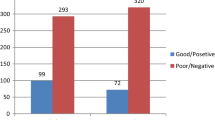Abstract
Aim
To assess knowledge and attitude of women toward postpartum intrauterine contraceptive device (PPIUCD) and analyze reasons of refusal.
Setting and Design
Hospital-based cross-sectional study for 1 year.
Materials and Methods
550 women were enrolled in the study. Sociodemographic characteristics, knowledge, and attitude toward contraception especially PPIUCD were noted, and the reasons for refusal of PPIUCD were analyzed.
Statistical Analysis
SPSS version 17.0 is used. Continuous variables were reported using mean, and categorical variables were reported using percentages.
Observations
PPIUCD insertion rate was 9.1 %. 78.6 % of women in the study belonged to the age group of 20–30 years, with 79.2 % having education of Class X and above. The overall contraceptive knowledge was 94.4 %. Although 48.4 % women were aware of Cu T as a method of contraception, only 21.9 % of 48.4 %, however, were aware of PPIUCD. None of the women had ever used it before. The commonest prevalent myths regarding Cu T were fear of malignancy (38 %) and fear of menorrhagia (36.4 %). The husband and mother-in-law played important roles in decision regarding PPIUCD insertion and refused the same in 59 % of cases.
Conclusion
The study shows that awareness of PPIUCD is low in this region despite good education, leading to high refusal rates. The commonest reason is lack of appropriate counseling, and not only the woman but the husband and mother-in-law also must be provided the knowledge of it as they play important roles in our society.
Similar content being viewed by others
References
Programming strategies for postpartum family planning. WHO Library Cataloguing-in-Publication Data. WHO 2013. www.who.int/iris/bitstream/10665/93680/1/9789241506496_eng.pdf. Accessed 20 June 2014.
International Institute for Population Sciences (IIPS) and Macro International: National Family Health Survey (NFHS-3), 2005–2006, India, Key Findings. Mumbai, IIPS. 2007. http://www.measuredhs.com/pubs/pdf/SR128/SR128.pdf. Accessed 15 June 2014.
Majhi AK. Importance of PPIUCD in perspective of present Indian population scenario. Indian J Perinatol Reprod Biol. 2012;2(2):5–7.
Grimes DA, Lopez LM, Schulz KF, et al. Immediate post-partum insertion of intrauterine devices. Cochrane Database Syst Rev. 2010;12:CD003036. doi:10.1002/14651858.CD003036.pub2.
Kapp N, Curtis KM. Intrauterine device insertion during the postpartum period: a systematic review. Contraception. 2009;80:327–36.
Long-term reversible contraception. Twelve years of experience with the TCu380A and TCu220C. Contraception. 1997;56:341–52.
Peterson HB, Xia Z, Hughes JM, et al. The risk of pregnancy after tubal sterilization: findings from the U.S. Collaborative Review of Sterilization. Am J Obstet Gynecol. 1996;174:1161–8.
Rustein SO. Further evidence of the effects of preceeding birth intervals on neonatal, infant and under five years mortality and nutritional status in developing countries: Evidence from the demographic and Health Surveys. DHS Working Papers, Demographic and Health Research 2008. http://dhsprogram.com/pubs/pdf/WP41/WP41.pdf. Accessed 20 June 2014.
Nigam A, Maheshwari N, Prakash A. Knowledge of emergency contraception and contraceptive practices: representative study from rural uttar pradesh. Indian J Community Med. 2010;35(3):449–50.
Kumar S, Sethi R, Balasubramaniam S, et al. Women’s experience with postpartum intrauterine contraceptive device use in India. Reprod Health. 2014;11:32.
Mohamed SA, Kamel MA, Shaaban OM, et al. Acceptability for the use of postpartum intrauterine contraceptive devices: assiut experience. Med Princ Pract. 2003;12:170–5.
Kanojia JK, Nirbhavane NC, Toddywala VS, et al. Dynamics of contraceptive practice amongst urban Indian women. 1996;9(3):109–12.
Saluja N, Sharma S, Choudhary S, et al. Contraceptive knowledge, attitude and practice among eligible couples of rural Haryana. Internet J Health. 2009;12(1). www.ispub.com. Accessed 20 June 2014.
Katheit G, Agarwal J. Evaluation of post-placental intrauterine device (PPIUCD) in terms of awareness, acceptance, and expulsion in a tertiary care centre. Int J Reprod Contracept Obstet Gynecol. 2013;2(4):539–43.
Compliance with Ethical Requirements and Conflict of Interests
All procedures performed in studies involving human participants were in accordance with the ethical standards of the institutional and/or national research committee and with the 1964 Helsinki declaration and its later amendments or comparable ethical standards. Informed consent was obtained from all the individual participants included in the study. Aruna Nigam, Ayesha Ahmad, Anshu Sharma, Poonam Saith, and Swaraj Batra declare that they have no conflicts of interest.
Author information
Authors and Affiliations
Corresponding author
Additional information
Aruna Nigam is working as an Associate Professor in the Department of Obstetrics and Gynaecology at Hamdard Institute of Medical Sciences and Research; Ayesha Ahmad is an Assistant Professor in the Department of Obstetrics and Gynaecology at Hamdard Institute of Medical Sciences and Research; Anshu Sharma is a Senior Resident in the Department of Obstetrics and Gynaecology at Hamdard Institute of Medical Sciences and Research; Poonam Saith is a Family Welfare Officer in the Department of Obstetrics and Gynaecology at Hamdard Institute of Medical Sciences and Research; Swaraj Batra is a Professor in the Department of Obstetrics and Gynaecology at Hamdard Institute of Medical Sciences and Research.
Rights and permissions
About this article
Cite this article
Nigam, A., Ahmad, A., Sharma, A. et al. Postpartum Intrauterine Device Refusal in Delhi: Reasons Analyzed. J Obstet Gynecol India 68, 208–213 (2018). https://doi.org/10.1007/s13224-015-0714-9
Received:
Accepted:
Published:
Issue Date:
DOI: https://doi.org/10.1007/s13224-015-0714-9




